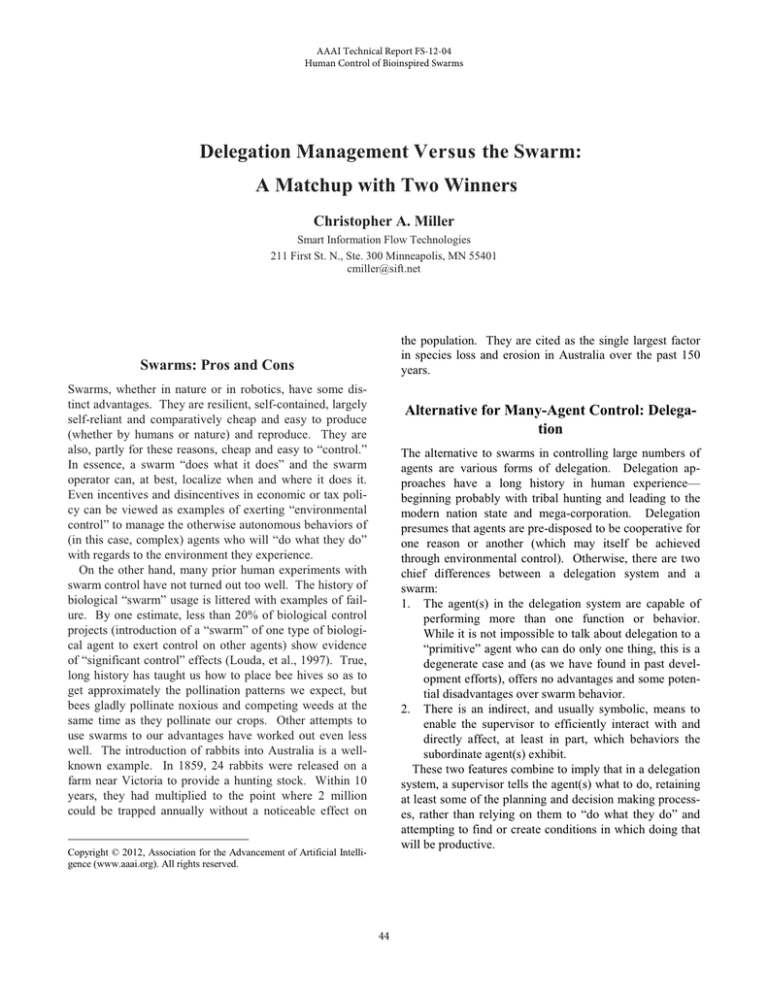Delegation Management Versus the Swarm: A Matchup with Two Winners
advertisement

AAAI Technical Report FS-12-04 Human Control of Bioinspired Swarms Delegation Management Versus the Swarm: A Matchup with Two Winners Christopher A. Miller Smart Information Flow Technologies 211 First St. N., Ste. 300 Minneapolis, MN 55401 cmiller@sift.net the population. They are cited as the single largest factor in species loss and erosion in Australia over the past 150 years. Swarms: Pros and Cons Swarms, whether in nature or in robotics, have some distinct advantages. They are resilient, self-contained, largely self-reliant and comparatively cheap and easy to produce (whether by humans or nature) and reproduce. They are also, partly for these reasons, cheap and easy to “control.” In essence, a swarm “does what it does” and the swarm operator can, at best, localize when and where it does it. Even incentives and disincentives in economic or tax policy can be viewed as examples of exerting “environmental control” to manage the otherwise autonomous behaviors of (in this case, complex) agents who will “do what they do” with regards to the environment they experience. On the other hand, many prior human experiments with swarm control have not turned out too well. The history of biological “swarm” usage is littered with examples of failure. By one estimate, less than 20% of biological control projects (introduction of a “swarm” of one type of biological agent to exert control on other agents) show evidence of “significant control” effects (Louda, et al., 1997). True, long history has taught us how to place bee hives so as to get approximately the pollination patterns we expect, but bees gladly pollinate noxious and competing weeds at the same time as they pollinate our crops. Other attempts to use swarms to our advantages have worked out even less well. The introduction of rabbits into Australia is a wellknown example. In 1859, 24 rabbits were released on a farm near Victoria to provide a hunting stock. Within 10 years, they had multiplied to the point where 2 million could be trapped annually without a noticeable effect on Alternative for Many-Agent Control: Delegation The alternative to swarms in controlling large numbers of agents are various forms of delegation. Delegation approaches have a long history in human experience— beginning probably with tribal hunting and leading to the modern nation state and mega-corporation. Delegation presumes that agents are pre-disposed to be cooperative for one reason or another (which may itself be achieved through environmental control). Otherwise, there are two chief differences between a delegation system and a swarm: 1. The agent(s) in the delegation system are capable of performing more than one function or behavior. While it is not impossible to talk about delegation to a “primitive” agent who can do only one thing, this is a degenerate case and (as we have found in past development efforts), offers no advantages and some potential disadvantages over swarm behavior. 2. There is an indirect, and usually symbolic, means to enable the supervisor to efficiently interact with and directly affect, at least in part, which behaviors the subordinate agent(s) exhibit. These two features combine to imply that in a delegation system, a supervisor tells the agent(s) what to do, retaining at least some of the planning and decision making processes, rather than relying on them to “do what they do” and attempting to find or create conditions in which doing that will be productive. Copyright © 2012, Association for the Advancement of Artificial Intelligence (www.aaai.org). All rights reserved. 44 Delegation: Pros and Cons The fact that agents in a delegation system m must be capable of exhibiting multiple behavioors for the system to be effective, coupled with thhe fact that they must be capable of receiving andd processing a symbolic communication meedium, means that they must generally be more com mplex than swarm agents. The degree of intelliigence possessed by the delegation agent makes iit possible to delegate at higher, more abstracct and aggregated levels of tasking or functionnality, through posing abstract goals or constraintts and Figure 1. A hypothesized trade off space for interacctions between a supervipriorities. This can make the delegation actt more sor and subordinates (from Miller and Parasuraman n, 2007). efficient and effective—which imposes a m motivahin a tradeoff space comsystemic relationship existed with tion for ever more complex agents. Finally, the fact that posed of three parameters, and that t manipulating one of the the communication medium between supeervisor and subon the others: parameters imposed consequences ordinate must be, and ideally remain, openn means that the x The competency of the human-machine system, that is, act of delegation and ongoing supervision can be more it’s ability to exhibit correct b ehavior across a range of complex and time- and workload consumingg than the act of contexts, “setting loose” a swarm. Together, these ffactors give rise x The workload required from thee supervisor achieve that to many of the known weaknesses of non-sw warm systems: competency, and A. They are more expensive to build and ooperate and may x The unpredictability of the systtem to the operator. Unrequire extensive training or developmeent time predictability refers to the inaability of the operator to B. They are generally less resilient to faillures of individknow exactly what the system m will do when. It can be ual agents mitigated to a degree through h good design, user interC. They are generally less resilient to failuures of commufaces and training, but it is a consequences c of offloadnication ing tasks and, especially, decision making to subordiD. They can require more time and attentiion from an opnates or automation. erator/supervisor The goal of a flexible delegation system, such as the On the other hand, the greater level of caapability and inPlaybook® approach we have been developing (Miller and telligence coupled with the ability to moree precisely comParasuraman, 2007; Miller, et al., a 2011; Miller et al., mand behaviors can combine to enable a m much more capa2012), is to provide the operator th he ability to dynamically ble system with a much greater range of prooductive behavchoose a configuration of these three parameters during iors, all under more precise control (with less unintended system use, as illustrated in Figuree 2. That is, the operator consequences), than a swarm. is able to decide whether to incur greater g workload by issuing more detailed commands and monitoring more closely to reduce uncertainty and, presu umably, achieve greater A TradeOff Space of Altern natives competency, or to tolerate potentiaal increases in uncertainty and decreases in competency allong with reduced workIn practice, of course, the alternatives exisst along a specload by issuing high level, abstracct delegation instructions trum. As the individual agents in a swarm gget even slightly smarter and/or are able to exhibit multiplee behaviors, the need to communicate with them and seleect and activate those different behaviors increases (withh corresponding reductions in speed of use, resiliency to ccommunications loss, etc.). And even the intelligent and hhighly complex agents can be interacted with in a swarm-likke fashion (such as the manager who tells his crew to “just gget busy and do something!”). In (Miller and Parasuraman, 2007), I sugggested the model in Figure 1 for characterizing different ttypes of human interaction with subordinate agents (whethher human, maFigure 2. Flexible delegation enablles dynamically choosing chine or any other type). The notion waas that any such what relationship is desired in the trradeoff space. 45 rarely. Of course, this flexibility is feasiblee only when the prerequisites of intelligent agents with diveerse capabilities and a communication mechanism for “discussing” activities are met. I suspect that the human-agent relationsship in a “pure” swarm system (one which exhibits only onne behavior and which operates fully autonomously once rreleased) should occupy a unique niche in my tradeoff spacce, as illustrated in Figure 3—extremely low workload to achhieve extremely narrow competency with extremely large unnpredictability. design, is to understand these attrributes and use them appropriately. Of course, in the nature of allternatives existing on a spectrum, at some point they blen nd into each other. Extremely limited delegation system ms, or delegation systems operating in conditions where interaction and the presumption of cooperation break down can c and will behave like swarms. Similarly, sophisticated swarms—which are capable of exhibiting alternate behaaviors which can be selected, commanded, or “influenceed” by a human operator and, especially, those which inclu ude a presumption of cooperation in their motivation—wiill start to take on attributes of delegation system includiing the need for greater complexity and communication maaintenance, as well as the ability to effect more precise and taargeted behaviors. Figure 3. Hypothesized relationship for a "puree" swarm system. Referencees This points to a flaw in the representationn scheme in these figures. There is a discrepancy betweeen workload required during “system operation”—that is, rrequired to task, monitor and retask the agents—and that required to create the conditions of use for the system (througgh design, training, or particularly in the case of swarm ms, environment selection and preparation) before hand. Hoow to treat such “outside the usage instance” work has beenn wrestled with, without a universally accepted solution, iin the work of (Goodrich and Olsen, 2003) and (Crandall and Cummings, 2007). Part of what makes swarms effective (aand what makes their unpredictability potentially dangerouus) is that their limited functionality requires careful selecttion of the conditions under which they are loosed to “doo what they do”. If they are released in inappropriate circuumstances, their performance will be suboptimal in somee fashion, and, while that decrement can reasonably be laiid at the feet of the human operator who failed to activate them appropriately, that may be small compensation ffor failures and missed opportunities. Nevertheless, that m means that effort (loosely, “workload” in the above figures) must be expended before hand to evaluate whether conditions are right for the behavior the swarm exhibits, and this is not included in the workload dimension (nor, foor that matter, is the workload required to select and train thhe more competent agents in a delegation system). Louda , S. M., Kendall, D., Connor, J., J and Simberloff, D. 1997. Ecological Effects of an Insect Introdu uced for the Biological Control of Weeds. Science, 277. 1088-1090. Miller, C. and Parasuraman, R. 2007. Designing for Flexible Interaction between Humans and Auttomation: Delegation Interfaces for Supervisory Control. Human n Factors, 49(1). 57–75. Miller, C., Shaw, T., Musliner, D., Hamell, H J., Emfield, A. and Parasurman, R., 2011. Delegation to o Automation: Performance and Implications in Off-Nominal Situ uations. In Proceedings of the 14th International Conference on Human Computer Interaction Orlando, FL. 9-14 July. Miller, C., Hamell, J. Barry, T., Rufff, H., Draper, M. and Calhoun, G., 2012. Adaptable Operatorr-Automation Interface for Future Unmanned Aerial Systems Control: C Development of a Highly Flexible Delegation Concept Demonstration. D In Proceedings of Infotech@Aerospace 2012 Conference, C American Institute of Aeronautics and Astronautics, Reston, R VA. Goodrich, M. and Olsen, D. 2003. Seven S principles of efficient human robot interaction. In Proceed dings of the IEEE International Conference on Systems, Man an nd Cybernetics. 3949-3948. Crandall, J. and Cummings, M. 2007 7. Developing performance metrics for the supervisory control of o multiple robots. In Proceedings of the 2007 ACM/IEEE Co onference on Human-Robot Interaction (HRI’07., 33-40 Final Thoughts To claim that one approach to accomplishinng desired goals is “better” than another is somewhat misssing the point. Each has characteristics which make it deesirable in some cases and less so in others. Each is also suubject to breakdown cases and inappropriate usage. The trrick, as in much 46




